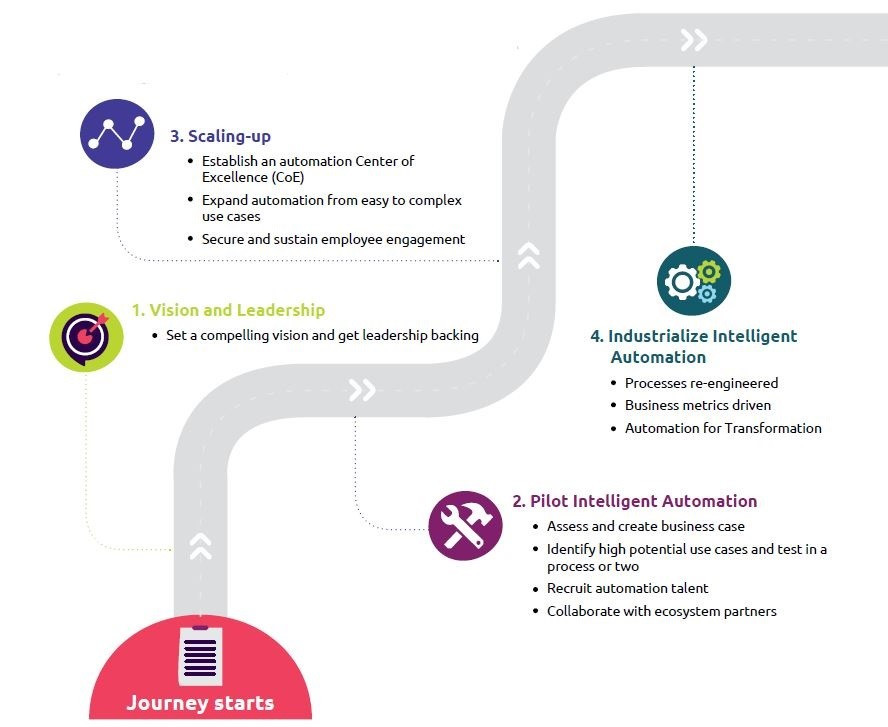Implementing intelligent automation in Insurance: A roadmap for success
Blog: Capgemini CTO Blog
As I mentioned in my earlier blog (Insurers face challenges as they seek to implement intelligent automation at scale), insurers are increasingly considering automation as a way to streamline processes and improve customer satisfaction. However, firms are facing challenges when it comes to implementation and scaling up.
In Growth in the Machine, Capgemini’s July 2018 report on the state of intelligent automation in the financial services industry, we found that some organizations were particularly successful in scaling up their intelligent automation deployments. Labeled Visionaries, these firms promote automation as a strategic initiative.
An analysis of Visionary characteristics offers insight into why these organizations were successful in their intelligent automation implementations. Visionary attributes also form the basis of an automation roadmap that other firms can follow to gain the full benefits from automation.
Four distinct phases can be used to map a firm’s automation journey: creating a vision and garnering leadership support, piloting intelligent automation, scaling up, and industrializing intelligent automation.
Automation transformation roadmap

Source: Capgemini Digital Transformation Institute Analysis, 2018
1. Creating a vision and garnering leadership support: Making automation a strategic priority sets a clear expectation for the firm’s automation initiative. It defines the purpose of automation and helps to ensure support and active engagement from senior leadership. By establishing a clear and compelling vision, insurers demonstrate to their people that intelligent automation is a strategic imperative. Project evangelists should be able to explain clearly what the firm is trying to achieve through automation – driving growth, cutting costs, or both? A compelling vision will secure both initial support and ongoing backing.
2. Piloting intelligent automation: To assess the impact of automation on an insurer’s processes, a business case will often be helpful. This will typically be easier with more mature tools, such as RPA, than with more embryonic options such as AI. Considering parameters – such as the volume of transactions or the number of exceptions that require human intervention – helps to identify the best automation solution for a process. It is a good idea to focus first on simple use cases with a short pay-back period. The firm can begin building automation capabilities by running small pilots.
Developing people capabilities is also critical at a time when the insurance industry is competing with BigTech and FinTech firms for automation talent. According to our study, Visionary insurers use innovative approaches to attract talent and often organize hackathons to identify top-notch candidates. Insurers can also train existing employees in automation technologies to encourage in-house expertise.
Collaboration with ecosystem partners such as InsurTech firms creates a win-win scenario. Since developing technology in-house can be time-consuming, access to ready-to-deploy automation solutions is an attractive prospect for incumbent insurers. InsurTechs can also refine their products by accessing and studying the vast amounts of customer data that incumbents possess.
- Scaling up: The establishment of a central team to govern intelligent automation opportunities will support adoption across business units. An automation center of excellence (CoE) that focuses on end-to-end automation ensures quick solution replication across different business units for similar use cases. Once the governance system is in place, the firm can also start piloting more complex use cases. The immediate focus can be the ones with quick pay-back times. Do consider the end-to-end transformation of an entire process, not just a few tasks within the process.
Automation initiatives impact the entire enterprise. It is wise to engage employees, educate them, and convince them to promote automation to help overcome potential resistance from individuals or groups. Employees must feel confident that automation will not replace them but will augment their efforts and increase the overall quality and quantity of output.
- Industrializing intelligent automation: In the last phase, organizations will embrace automation as an enterprise-wide transformation program. A smart, holistic approach ensures that the insurer reengineers processes to remove exceptions. They will also measure benefits at an enterprise level rather than at a use case or process level.
Achieving scale and driving value from intelligent automation solutions is strategically critical to insurers. The roadmap I have described can help begin the conversations that will lay the groundwork for enterprise-wide benefits.
For more information about the benefits of automation and the obstacle-clearing strategies employed by insurance firms worldwide, download a copy of the World Insurance Report 2018 from Capgemini and Efma.
Leave a Comment
You must be logged in to post a comment.








